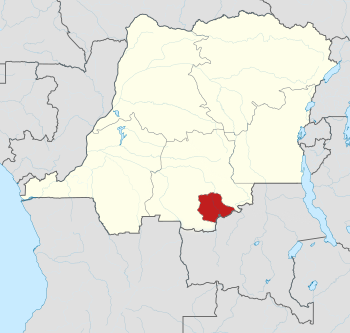جنوب كاساي
| ||||||||||||||||||||||||||||||||||||||||||||||||||||||||
جنوب كاساي (إنگليزية: South Kasai؛ فرنسية: Sud-Kasaï) كانت دولة انفصالية معلنة من طرف واحد غير معترف بها داخل جمهورية الكونغو (جمهورية الكونغو الديمقراطية الحالية)[أ] which was quasi-independent between 1960 and 1962. Initially proposed as only a province, South Kasai sought full autonomy in similar circumstances to the much larger neighbouring state of كاتنگا, to its south, during the political turmoil arising from the independence of the الكونغو البلجيكي known as the أزمة الكونغو. Unlike Katanga, however, South Kasai did not explicitly declare full independence from the Republic of the Congo or reject its claim to sovereignty.
The South Kasaian leader and main advocate, Albert Kalonji, who had represented a faction of the nationalist movement (the Mouvement National Congolais-Kalonji or MNC-K) before decolonisation, exploited ethnic tensions between his own ethnic group, the Baluba,[ب] and the Bena Lulua to create a Luba-focused state in the group's traditional heartland in the south-eastern parts of the منطقة كاساي.
خلفية
الحكم الاستعماري
الحركة الوطنية والسياسة الكونغولية

شقاق كالونجي-لومومبا والاستقطاب

الانفصال
الدعم الدولي

إلقاء القبض على كالونجي
الأعقاب
في كاساي
نهاية أزمة الكونغو
انظر أيضاً
الهامش والمراجع
الملاحظات
- ^ يجب ألا تـُخلط مع الدولة المجاورة المعروفة حالياً بإسم جمهورية الكونغو، والتي كانت في السابق الكونغو الفرنسي، وعاصمتها برازاڤيل. اسم الدولة تغير إلى جمهورية الكونغو الديمقراطية في أغسطس 1964.[1]
- ^ In most Bantu languages, the prefix ba- is added to a human noun to form a plural. As such, Baluba refers collectively to members of the Luba ethnic group. Its adjectival form is Muluba.
المراجع
- ^ EISA 2002.
- ^ Dufresne 2011, p. 26.
ببليوگرافيا
- Boulden, Jane (2001). Peace Enforcement: The United Nations Experience in Congo, Somalia, and Bosnia (1st ed.). Westport, Conn.: Praeger. ISBN 0-275-96906-1.
{{cite book}}: CS1 maint: ref duplicates default (link) - Bring, Ove (2011). Hammarskjöld's approach to the United Nations and international law. Documentos. Chile: Instituto de estudios internacionales.
{{cite book}}: CS1 maint: ref duplicates default (link) - "DRC: Background to the 1965 election". Electoral Institute for Sustainable Democracy in Africa (EISA). Retrieved 8 July 2014.
- Dufresne, André (January 2011). "Les Timbres-poste du Sud-Kasaï" (PDF). Philatélie Québec (292): 25–31.
{{cite journal}}: CS1 maint: ref duplicates default (link) - Freund, Bill (1998). The Making of Contemporary Africa: The Development of African Society since 1800 (2nd ed.). Basingstoke: Palgrave-Macmillan. ISBN 978-0-333-69872-3.
{{cite book}}: CS1 maint: ref duplicates default (link) - Gondola, Charles Didier (2002). The History of Congo. Wesport (Conn.): Greenwood. ISBN 0-313-31696-1.
{{cite book}}: CS1 maint: ref duplicates default (link) - Haskin, Jeanne M. (2005). The Tragic State of the Congo: From Decolonization to Dictatorship. New York: Algora Publishing. ISBN 0-87586-416-3.
{{cite book}}: CS1 maint: ref duplicates default (link) - Lowenstein, Frank W. (1962). An Epidemic of Kwashiorkor in the South Kasai, Congo (PDF). Vol. 27. pp. 751–8.
{{cite book}}:|journal=ignored (help)CS1 maint: ref duplicates default (link) - Mopipi, Jacky (15 March 2010). "Que sont-ils devenus?: Albert Kalonji-Ditunga dit Mulopwe". Congo Indépendant. Retrieved 12 November 2014.
- Ngapi, Rich (15 August 2008). "Congo-Kinshasa: Le 8 août 1960, Albert Kalonji proclame l'autonomie du Sud-Kasaï". Le Potentiel. Retrieved 25 November 2014.
- Nugent, Paul (2004). Africa since Independence: A Comparative History. New York: Palgrave-MacMillan. ISBN 978-0-333-68273-9.
{{cite book}}: CS1 maint: ref duplicates default (link) - Nzongola-Ntalaja, Georges (2007). The Congo, From Leopold to Kabila: A People's History (3rd ed.). New York: Palgrave. ISBN 978-1-84277-053-5.
{{cite book}}: CS1 maint: ref duplicates default (link) - Packham, Eric S. (1996). Freedom and Anarchy. New York: Nova Science. ISBN 1-56072-232-0.
{{cite book}}: CS1 maint: ref duplicates default (link) - Pakenham, Thomas (1992). The Scramble for Africa: the White Man's Conquest of the Dark Continent from 1876 to 1912 (13th ed.). London: Abacus. ISBN 978-0-349-10449-2.
{{cite book}}: CS1 maint: ref duplicates default (link) - The Management of Secondary Cities in Sub-Saharan Africa: Traditional and Modern Institutional Arrangements. Nairobi: UNCHS (Habitat). 1991.
- Turner, Thomas (2007). The Congo Wars: Conflict, Myth, and Reality (2nd ed.). London: Zed Books. ISBN 978-1-84277-688-9.
{{cite book}}: CS1 maint: ref duplicates default (link) - Willame, Jean-Claude (1972). Patrimonialism and Political Change in the Congo. Stanford: Stanford University Press. ISBN 0-8047-0793-6.
{{cite book}}: CS1 maint: ref duplicates default (link) - Zeilig, Leo (2008). Lumumba: Africa's Lost Leader. London: Haus. ISBN 978-1-905791-02-6.
{{cite book}}: CS1 maint: ref duplicates default (link)
للاستزادة
- Crawford Young, M. (1965). Politics in the Congo: Decolonization and Independence. Princeton: Princeton University Press. OCLC 307971.
- Dedeken, Noël C. (1978). Chimères Baluba: Le Sud-Kasaï, 1960–1962 à feu et à sang. Brussels: Dedeken Editeur. OCLC 70737994.
- De Witte, Ludo (2002). The Assassination of Lumumba (Trans. ed.). London: Verso. ISBN 1-85984-410-3.
- Kalonji Ditunga Mulopwe, Albert (2005). Congo 1960, la sécession du Sud-Kasaï: La vérité du Mulopwe. Paris: L'Harmattan. ISBN 2-7475-8132-2.
- Keller, Edmond J. (2007). "Secessionism in Africa". Journal of African Policy Studies. 13 (1): 1–26.
- Muyumba, Valentine Kanyinda (2004). "Luba-Kasai: A Working Bibliography". Electronic Journal of Africana Bibliography. 9.
وصلات خارجية
- The War in the Congo: Mutiny, Secession, and Foreign Intervention at the Centre for Research on Globalization
- Congo-Zaïre : l'empire du crime permanent : le massacre de Bakwanga at Le Phare
- La Vérité sur le Sud-Kasaï at the Association Kasayienne d'Entre-aide Mutuelle
- Pages using gadget WikiMiniAtlas
- Pages using infobox country with unknown parameters
- Pages using military navigation subgroups without wide style
- Articles containing إنگليزية-language text
- Pages using Lang-xx templates
- Articles containing فرنسية-language text
- Pages with empty portal template
- CS1 maint: ref duplicates default
- CS1 errors: periodical ignored
- Coordinates on Wikidata
- تاريخ جمهورية الكونغو الديمقراطية
- الانفصال في جمهورية الكونغو الديمقراطية
- بلدان سابقة غير معترف بها
- أزمة الكونغو
- دول وأقاليم تأسست في 1960
- كيانات سياسية سابقة في الحرب الباردة







